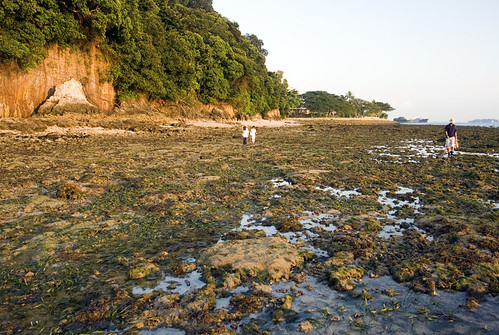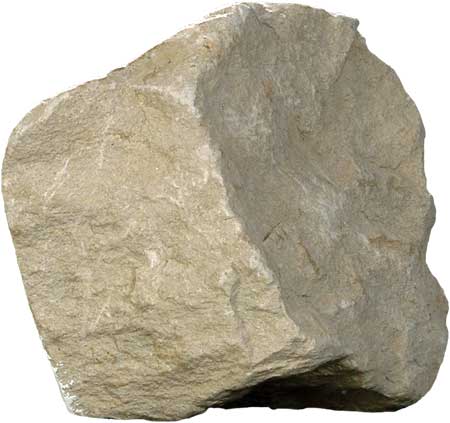
Siloso Point, Sentosa Island, Singapore
About Sedimentary Rocks
Sedimentary rocks are one of the three major classes of rocks (the other two being igneous and metamorphic) and the term refers to rocks that are formed from sediments (that is, rocks and minerals that collect on the ground or at the bottom of water bodies). These sediments mainly come from the weathering and erosion of rocks and occasionally the shells and remains of living organisms. Over time, pressure and/or chemical reactions will convert these sediments into tougher material; creating the entire class of rocks we call sedimentary rocks.
A distinguishing feature of sedimentary rocks as a whole is that they tend to form horizontal bands in their formation, which is known as bedding. These beds can be a few millimetres to a few metres thick, depending on how the material was deposited. These beds tell us the sequence of deposition of material, since different materials, originating from different times and places will have different properties and colours. The type of sedimentary rocks also changes across the beds, with sandstones alternating with conglomerates and siltstone in the same area, testament to the changing geography of the area over time.

Example of Bedding in Sedimentary Rocks
Sedimentary rocks cover most of Earth’s surface, but the only constitute a small volume of the Earth’s crust (less than 10%). This is because sedimentary rocks form very close to the surface of the Earth, and tectonic movement will push these rocks upwards. Sedimentary rocks are immensely important in palaeontology (the study of life on Earth before the emergence of humans) as they are the type of rocks most likely to contain the fossils of dinosaurs. In addition, they tend to contain valuable information about the physical geography of an area in the past. Areas containing deposits of limestone, for instance would indicate that the area was once at the bottom of the sea, before being pushed up by tectonic movements.
Types of Sedimentary Rocks
Sedimentary rocks are further subdivided into groups, depending on the processes and substances that form them, so let us examine them in turn.
Clastic sedimentary rocks
Clastic rocks are named so as they are made of clasts, that is, weathered or eroded rock material that have been cemented together. These rocks are the most varied of the sedimentary and their identity depends on the size of the clasts that make them up. In order of the largest to smallest clasts, they are named as follows:
Conglomerates: These rocks are made up of gravel (pebbles of size of a millimetre or more) cemented together to form a larger rock. They are easily identified by the fact that they are made up of a patchwork of other rounded rocks, of various colours and origin.

Conglomerate rock
Breccias: These guys are the cousins of conglomerates. They, too, are made up of gravel measuring a few millimetres of more, usually originating from a landslide of some sort. They differ from conglomerates in the sense that breccias are made up of more angular, less weathered pebbles while conglomerate are made up of more rounded, more weather pebbles.
Sandstones: Sandstones, as their name suggests, are made up of sand grains cemented together to form a tough rock. Don’t let their composition fool you; sandstones are a fairly tough rock, a few times harder than concrete. They present themselves in beautiful bright colours, from white to orange to red. They form some of the most beautiful geological formations, including the many canyons of the American West, such as the Grand Canyon. Sandstone can be identified by their sand sized grain, which is smaller than that of a pebble, but still big enough to be seen by the naked eye.

Sandstone rocks at Antelope Canyon, Arizona
Mudstones, Claystones and Siltstones: Like sandstones, these rocks also present themselves in a multitude of colours. They are so named because they are made out of silt and clay particles, which are almost too small to make out with the naked eye. Claystones contain more clay, siltstones contain more silt and mudstones are somewhere in the middle. In the field, it is quite difficult to distinguish between them, so, here we will classify them as one.

Mudstone Sample
Shale: is a specific form of mudstone, identified from the fact that it breaks into thin parallel layers when the rock undergoes layering
Biochemical Sedimentary Rocks
Biochemical rocks are rocks made from the remains of living organisms, such as corals and molluscs (shellfish). These organisms take in calcium from the sea water to make calcium carbonate, which is the primary composition of the corals and seashells. Over time, as these creatures die, their remnants form sediments at the bottom of oceans, and with pressure, the sediments form rocks made out of calcium carbonate, which we call limestone.
Other plant and animal material will lead to the formation of rocks like the carbon-rich coal or even petroleum and natural gas (but the last two are no longer rocks)
Chemical Sedimentary Rocks
Chemical rocks are rocks made simply from the deposition of minerals and salts that have precipitated from water. These are the rocks salts that have names like halite and gypsum.
The Sedimentary Rocks of Singapore
A large part of the western and southern part of Singapore (including the Southern Islands like St. John’s, Lazarus, Jurong Island and Sentosa) are made up of sedimentary rocks which form a larger formation of rocks collectively known as the Jurong Formation. These rocks from the backbone of the Southern Ridges (stretching from Kent Ridge to Mount Faber), the hills that form Sentosa Island (Serapong, Imbiah and Siloso) and the cliffs of Labrador Park. The Jurong Formation is made of a myriad of sedimentary rocks, namely siltstone, mudstone, limestone, shale, conglomerate and sandstone. The sea cliffs of Siloso Point are made up of a number of these sedimentary rocks of differing colours and type.

Geological Map of Singapore. Jurong Formation is the white area covering most of southern and western Singapore
Here, at Siloso Point, you will be examining a range of rocks from this ensemble, and identifying them. To aid you in your tasks, I have specially prepared a diagram (called a dichotomous key) to help you identify the types of rock in the Jurong Formation. It takes the form of a flowchart, beginning from the left, where you have to answer a series of questions to choose the next path in the diagram. At the end of the path, you would have found the identity of your rock.

Dichotomous key for the identification of sedimentary rocks in Singapore
The Earthcache Tasks
(Note: The waypoints are numbered from East to West, from Underwater World Sentosa to the tip of Siloso Point)
- At WP 1 and WP 3, you will observe outcrops of stones of a dark colour. Describe these stones according to the dichotomous key and, hence, identify these stones.
- At WP 2, you will observe light coloured stones with a beautiful pattern at your feet. Describe these stones according to the key and identify them. In addition, suggest a reason for the patterns of the stone. Read the listing closely, and you’ll find the reason
- At WP 4 and 5, you will see a pinkish coloured stone outcrops made of a combination of two types of stones. Identify both types of stones, and tell me the reasons why you proposed these identities.
- Optional: Feel free to log pictures of the flora and fauna along the coastline, and the view from the coast. You are exploring one of Singapore’s very last rocky shores, a habitat that can only be found in only two or three other places in this nation thanks to extensive land reclamation which creates artificial coastlines. Please DO NOT post close-up pictures of the rocks, as this will potentially give away the answers to the above three tasks.
You are to email me the answer to all three tasks above. Photologs as sole proof of visit is insufficient, and logs that are not accompanied with an email with the answers will be deleted.
Important Field Notes
- The route to this cache is tidal, which means that it can only be accessed at low tides. Any low tide below 1.0 metres will suffice as I explored the coast with a tide of 0.8 metres when I researched for this cache. Do not get caught out by the tide, or you will end up doing a little wading.
- This cache is along one of the routes to “Cliffhanger (Tidal Cache)” (http://coord.info/GCXYR8). You may combine this cache with an expedition to that one. In fact, WP5 is just no more than 100 metres from that cache.
- Some of the rocks may be slippery when wet. Exercise caution when attempting this cache, try not to do this cache alone, wear good shoes and bring a hiking pole, if required.
- The area is home to a sensitive ecosystem and an increasingly rare habitat in Singapore. Please do not fish, disturb any creatures in the area, litter or damage the area in any way. Also, no swimming is allowed! Stepping in the water is potentially dangerous as stonefish and jellyfish may be lurking in the waters. They are positively nasty to come into contact with.
- The closest car parking lot is at Underwater World Sentosa, where you can begin the hike to the cache almost immediately. For those who are not driving, you may take Bus Route 1 and 2 from almost any part of the island. Good starting points would be Beach Station, the Merlion or even Resorts World Sentosa. You are to alight at the Siloso Point bus stop.
Good luck Earthcaching, and stay safe! Most importantly, have fun!